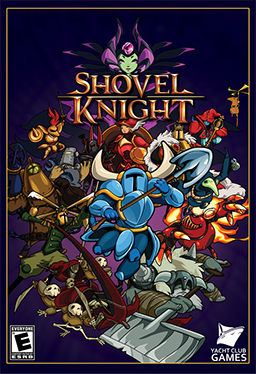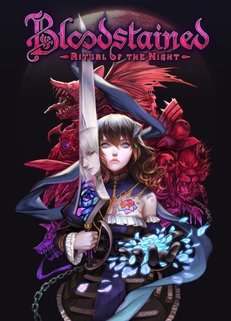
Castlevania, known in Japan as Akumajō Dracula, is a gothic horror action-adventure video game series and media franchise about Dracula, created and developed by Konami. It has been released on various platforms, from early systems to modern consoles, as well as handheld devices such as mobile phones. The franchise has expanded into several spin-off video games and other media, including comic books and an animated television series.
The Konami Code, also commonly referred to as the Contra Code and sometimes the 30 Lives code, is a cheat code that appears in many Konami video games, as well as some non-Konami games. In the original code, the player has to press the following sequence of buttons on the game controller to enable a cheat or other effects:

Castlevania: Symphony of the Night is a 1997 action role-playing game developed and published by Konami for the PlayStation and Sega Saturn. It was directed and produced by Toru Hagihara, with Koji Igarashi acting as assistant director. It is a direct sequel to Castlevania: Rondo of Blood, taking place four years later. It features Dracula's dhampir son Alucard as the protagonist, rising from his slumber to explore Dracula's castle which resurfaced after Richter Belmont vanished. Its design marks a break from previous entries in the series, re-introducing the exploration, nonlinear level design, and role-playing elements first experimented with in Castlevania II: Simon's Quest.

Castlevania II: Simon's Quest is a 1987 action role-playing game developed and published by Konami. It was originally released in Japan in 1987 for the Famicom Disk System, and in North America in 1988 for the Nintendo Entertainment System. It is the second Castlevania game released for the NES, following the original Castlevania (1986). Set seven years after the events of the first installment, the player once again assumes the role of vampire hunter Simon Belmont, who is on a journey to undo a curse placed on him by Dracula at the end of their previous encounter. Dracula's body was split into five parts, which Simon must find and bring to the ruins of Castle Dracula in order to defeat him. The game deviates from the traditional platforming of its predecessor, incorporating role-playing and open world elements.

Castlevania III: Dracula's Curse is an action-adventure platform video game developed and published by Konami for the Nintendo Entertainment System. It was released in Japan in 1989, and in North America in 1990, and in Europe by Palcom in 1992. It was later released on the Virtual Console for the Wii, Nintendo 3DS, and Wii U.

Super Castlevania IV is a platform video game developed and published by Konami for the Super Nintendo Entertainment System. It has been re-released multiple times, including for the Super NES Classic Edition.

Castlevania: Bloodlines, known in Japan as Vampire Killer and in PAL regions as Castlevania: The New Generation, is a platform game developed and published by Konami in 1994 for the Sega Genesis, part of the Castlevania series. A vampire named Elizabeth Bartley is orchestrating the beginning of World War I as a sacrificial war to bring her uncle, Dracula, back to life. Players take on the role of Quincey Morris' son, John, and his friend Eric Lecarde to take up the fight against evil.
Ayami Kojima is a Japanese artist. She has often worked in video games as a character designer and is most known for her work on the Castlevania series of video games with Konami. She is self-taught and enjoys reading shōnen manga.

Koji Igarashi is a Japanese video game producer, programmer, writer, and creative director. In 2009, he was chosen by IGN as one of the top 100 game creators of all time.
Inti Creates Co., Ltd. is a Japanese video game development company. Formed by ex-Capcom staff in May 1996, they are best known for developing games in the Mega Man series, namely the Mega Man Zero and Mega Man ZX series, and their flagship Azure Striker Gunvolt and Gal Gun franchises.

Castlevania: Order of Ecclesia is a 2008 action role-playing game and the third Nintendo DS installment of the Castlevania franchise. Directed by Akihiro Minakata, with producer Koji Igarashi returning. The plot involves Shanoa, who is part of an organization set to defeat Dracula after the Belmont clan has vanished.

Castlevania, known in Japan as Akumajō Dracula, is a platform game developed and published by Konami for the Family Computer Disk System video game console in Japan in September 1986. It was ported to cartridge format and released in North America for the Nintendo Entertainment System (NES) in May 1987 and in Europe in 1988. It was also re-issued for the Family Computer in cartridge format in 1993. It is the first game in Konami's Castlevania video game series.

Gal Gun, stylized as Gal★Gun, is a Japanese bishōjo rail shooter game developed by Inti Creates and published by Alchemist. It was first released on Xbox 360 in 2011, followed by a PlayStation 3 port a year later. The game takes place in a fictional academy in Japan, where the player takes the role of a male student, Tenzou Motesugi. He must shoot his female classmates, who are running desperately after him, with "Pheromone Arrows" to prevent them from making their partner, while he finds one of the four lead girls before sunset.

Shovel Knight is a platform video game developed and published by Yacht Club Games. Development was crowdfunded and the game was released for Nintendo 3DS, Wii U, and Windows in June 2014. It was ported to OS X and Linux in September 2014, PlayStation 3, PlayStation 4, PlayStation Vita, and Xbox One in April 2015, Amazon Fire TV in September 2015, and Nintendo Switch in March 2017. Shovel Knight is inspired by gameplay and graphics of platformer games developed for the Nintendo Entertainment System.

Azure Striker Gunvolt, known as Armed Blue: Gunvolt in Japan, is a 2D side-scrolling action-platform game developed and published by Inti Creates. It was first released for Nintendo 3DS via eShop in August 2014. Ports of the game were released for Windows in 2015, for Nintendo Switch in 2017, for PlayStation 4 in 2020, and for Xbox One and Xbox Series X/S in 2022. In addition to utilizing gameplay similar to Mega Man Zero, Azure Striker Gunvolt also introduced new gameplay elements such as Gunvolt's ability to "tag" enemies and target many at once, adding an additional layer of complexity to the genre.

Metroidvania is a sub-genre of action-adventure games and/or platformers focused on guided non-linearity and utility-gated exploration and progression. The term is a portmanteau of the names of the video game series Metroid and Castlevania, based on the template from Metroid (1986), Castlevania II (1987), Super Metroid (1994), and Castlevania: Symphony of the Night (1997).

Bloodstained: Ritual of the Night is a Metroidvania-styled video game developed by Japanese indie studio ArtPlay and published by 505 Games. The game's development was led by former Castlevania series producer Koji Igarashi and is considered a spiritual successor to the series. The game was released for PlayStation 4, Windows, Xbox One, and Nintendo Switch, in June 2019, for Amazon Luna in October 2020, for Android and iOS in December 2020, and for Stadia in July 2021.

Shantae is a series of platform video games developed by WayForward. The eponymous heroine of the series, a half-genie, was created by Erin Bozon, while the games for this character were created by her husband Matt Bozon. The series consists of five games: Shantae (2002), Shantae: Risky's Revenge (2010), Shantae and the Pirate's Curse (2014), Shantae: Half-Genie Hero (2016) and Shantae and the Seven Sirens (2019). A sixth title, Shantae Advance: Risky Revolution, is in development and scheduled for release in 2024.

Bloodstained: Curse of the Moon 2 is a platform video game developed and published by Inti Creates. It was released for Nintendo Switch, PlayStation 4, Windows, and Xbox One, on July 10, 2020. It is the third game in the Bloodstained series and a direct sequel to Bloodstained: Curse of the Moon, itself a spin-off of Bloodstained: Ritual of the Night. The game's graphics and gameplay are done in an 8-bit retro style meant to mimic the early Castlevania games.

Gal Guardians: Demon Purge is a 2023 platform video game developed and published by Inti Creates. It is a spinoff of Gal Gun.


















